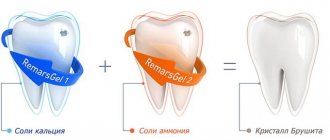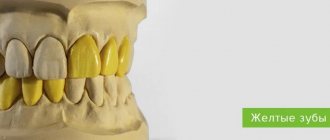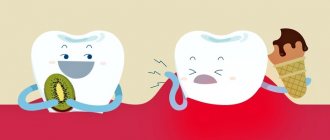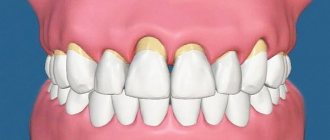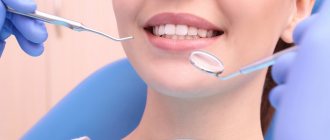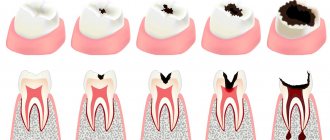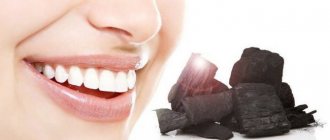What is dental fluoridation?
Fluoridation of teeth is a type of therapeutic effect on the surface of teeth, which helps strengthen them and prevents the development of many diseases.
This procedure is indicated both for thinning tooth enamel and as a prevention of caries. In the process of its implementation, various types of medicinal compositions are used. All of them enrich tooth enamel with fluoride ions - the most important mineral responsible for the strength and longevity of teeth. Regular fluoridation of enamel reliably protects teeth from the negative effects of acidic environments and harmful bacteria. First of all, fluoridation of enamel is recommended:
- Persons with increased tooth sensitivity;
- With a high risk of developing caries.
The procedure is absolutely painless, so it can be performed even on the youngest patients.
Why is tooth enamel destroyed?
The main cause of enamel destruction is the accumulation of organic acids in the oral cavity. Weakened, or demineralized, enamel is unable to withstand environmental risk factors. This inevitably leads to bacteriological contamination and increased sensitivity of the teeth.
Causes of enamel demineralization:
- Unhealthy diet;
- Low fluoride content in drinking water;
- Lack of calcium in the body;
- Pathogenic microorganisms in the oral cavity;
- Violations of the chemical composition of saliva;
- Negative impact of external factors;
- Insufficient oral care;
- Age-related changes.
These factors affect the condition of the oral cavity and the strength of tooth enamel. Weakened enamel is not able to fight the proliferation of cariogenic bacteria. The interaction of microorganisms that make up dental plaque leads to the formation of a carious lesion. This means that microdefects appear on the enamel surface. Prolonged neglect of demineralization will result in the stronger layers of enamel being affected over time. As a result, a comfortable environment is created for the proliferation of pathogenic bacteria and accelerated tooth decay.
Fluoridation of tooth enamel will help stabilize the condition and compensate for the lack of minerals.
What is fluoridation of teeth?
There are several methods of fluoride prevention of dental caries. The optimal solution would be the integrated use of a systemic and local source of fluoride, since the isolated use of one method may be insufficient.
Types of fluoridation:
- Drinking fluoridated drinking water;
- Fluoride tablets;
- Cleaning your teeth with a toothpaste containing fluoride;
- Simple fluoridation;
- Deep fluoridation.
Systematic consumption of fluoride-enriched water increases the concentration of fluoride ions in saliva and the oral cavity. This can compensate for the deficiency of fluoride in dental plaque and in the upper layers of enamel. However, in cases of severe demineralization, oral fluoride prophylaxis may not be sufficient. There are frequent cases of caries among adolescents, since external drugs are not able to penetrate thick layers of plaque.
Simple fluoridation of teeth
Simple fluoridation is carried out in the clinic in two ways:
1. Gel fluoridation course;
Before the procedure, the dentist removes plaque from the surface of the teeth and isolates the tooth surface from saliva using cotton pads. A special mouthguard that follows the shape of the teeth is filled with fluoride-containing gel and applied to the surface of the teeth for 5-10 minutes. Then the excess drug is removed from the oral cavity. After completing the procedure, you should refrain from drinking and eating for two hours.
In order for fluoride ions to penetrate the tooth enamel as deeply as possible, it is recommended to undergo the procedure up to 10-15 times (as prescribed by the doctor). The course should be repeated every six months.
2. Strengthening the enamel with sealing varnish.
Prolongs the effect of enamel fluoridation. The dentist cleans and dries the surface of the teeth. The varnish is applied with a brush to the surface of the enamel from the inside and outside and dried again. After which it hardens on the teeth, forming a fluoride-sealing film on the enamel, which remains in the areas of demineralization for up to several weeks. After applying fluoride varnish, it is not recommended to eat solid food or brush your teeth for 12-24 hours. Even a single application of varnish increases the concentration of fluoride in enamel by up to 77%. The procedure is painless and effective for children. The frequency of repetition depends on individual indicators and is determined by the attending physician. In most cases, this is 2 times every six months.
However, despite a noticeable reduction in karyotic formations, simple fluoridation is effective only for superficial damage to the enamel. In order for calcium fluoride to penetrate deep into the enamel, the deep fluoridation method is used.
TIPS FOR STRENGTHENING ENAMEL
Taking care of your teeth should include proper nutrition. Without it, preventative medical procedures will be of little benefit. A complete menu to strengthen teeth enamel should include the following foods:
- dairy products: they all contain phosphorus and calcium;
- hard root vegetables - carrots, radishes, apples, cabbage: chewing activates the secretion of saliva, which cleans the crown of the teeth;
- parsley: essential oils of this plant suppress the activity of microorganisms, which affects the cleanliness and safety of teeth and the strength of their coating;
- green tea: tea leaves contain fluoride in their structure, which prevents the formation of plaque and the accumulation of bacteria on the teeth;
- chicken eggs and seafood: they contain iodine, which helps strengthen the enamel.
It is necessary to take care of strengthening teeth from the appearance of the first primary incisor. Those parents who consider their baby’s baby teeth to be temporary and unimportant are deeply mistaken. It is the health of baby teeth that determines the health of future molars.
After six years, a child definitely needs to prevent caries using the drug Fluorlak Omega and other gels/solutions for teeth. Treatment must be prevented by preventing diseases, then dental health will be strong and the enamel will be strong.
Deep fluoridation of teeth
Deep fluoridation of teeth is a highly effective method of strengthening and local fluoride prevention of dental caries. The principle of operation of the procedure is to treat tooth enamel with a fluoride-based medicinal composition. Unlike previous methods, deep fluoridation is characterized by a more pronounced and lasting result.
Advantages of deep fluoridation:
- Increased content of fluorine-containing components;
- Protection against the development of caries;
- Strengthening tooth enamel;
- Extending the service life of fillings;
- Reduced tooth sensitivity;
- Easy to carry out;
- Affordable pricing policy.
The results of scientific research and patient reviews have repeatedly confirmed that deep fluoridation of enamel reduces tooth sensitivity and protects them from destruction over time.
The deep fluoridation method consists of sequential treatment of hard tooth tissues with a special fluoride-containing solution. Filling demineralized areas and microcracks, the substance penetrates the enamel. The surface of the tooth is compacted, a reliable crystalline and bactericidal barrier is created, protecting the tooth from destruction.
Thanks to careful processing, fluoride ions lie not only on the surface, but also deep in the pores of the enamel. This prevents their premature leaching and prolongs the effect of deep fluoridation from six months to two years. In addition, there is a constant release of fluoride ions in the concentration necessary to completely restore the enamel structure in the area of demineralization.
Advantages of fluoridation compared to silver plating
Previously, silver plating was used as a preventative measure. But most leading dental clinics abandoned it in favor of deep fluoridation. Here are the reasons:
|
Dentists speak flatteringly about the deep fluoridation procedure. In an interview with the newspaper “Arguments and Facts”, maxillofacial surgeon David Grigoryan Fr.
You can carry out deep fluoridation at our Nikadent clinic in Mytishchi. The cost of the service is quite affordable - about 2.5 thousand rubles. This price includes: professional consultation, preparation, cleaning of tartar, drying of teeth, application of fluoride.
Contraindications and indications
Indications for using the deep fluoridation method:
- Treatment of hyperesthesia (high sensitivity) of teeth;
- Treatment and prevention of dental caries;
- Mineral (non-invasive) fissure sealing;
- Treatment of marginal periodontitis.
Contraindications:
- The presence of caries in the active stage;
- Excessive fluoride content in the body;
- Having an allergic reaction to one of the components of the procedure;
- Severe toxicosis during pregnancy.
Despite the simplicity and safety of this procedure, you should consult your doctor before performing it.
Prices for pediatric dentistry
| Child therapy | |
| Children's professional oral hygiene | 2,200 rub. |
| Filling teeth with glass ionomer cement (Fuji, Vitremer) | 1,500 rub. |
| Dental treatment using vital amputation in one visit (excluding anesthesia) | 3,600 rub. |
| Seal “Dyract” | 2,200 rub. |
| Pulp amputation with placement of a therapeutic bandage | 1,200 rub. |
| Mechanical and medicinal treatment of carious cavity | 500 rub. |
| Application of devitalizing paste | 500 rub. |
| Deep fluoridation of all teeth | 2,500 rub. |
| Carrying out the resorcinol-formalin method (one session) | 700 rub. |
| Filling root canals with paste (one canal) | 300 rub. |
| Carrying out the method of silvering baby teeth (one tooth) | 200 rub. |
| Application of medicinal paste “Pulpotek” | 1,000 rub. |
| Temporary chemical filling | 300 rub. |
Stages of fluoridation
Deep fluoridation of tooth enamel is carried out in several stages:
- Cleaning teeth and interdental spaces from plaque;
- Drying teeth;
- Application of medicinal composition No. 1 (calcium and magnesium fluoride) to the enamel surface;
- Application of preparation No. 2 (calcium hydroxide);
- Removing drug residues.
You can eat food immediately after the procedure. To consolidate the result in the first hours, it is recommended to avoid too hard and hot foods. Deep fluoridation is carried out without pain and is safe for children.
Why is fluoridation necessary for children?
The body in childhood experiences fluoride deficiency. The main factors influencing this are:
- Genetic predisposition.
- General condition of the body. For example, some diseases increase the lack of fluoride, and teeth weaken.
- Poor nutrition.
- Lack of normal child development.
| Due to the factors listed above, tooth enamel weakens and they become sensitive to any changes. The child feels pain when drinking cold or hot drinks or food. Without fluoride, enamel is destroyed and teeth become vulnerable to disease. If caries begins to develop in childhood, there is a high probability that by the age of 30 a person will be missing at least several teeth. Deep fluoridation is an effective preventive measure that increases the resistance of teeth to negative external influences. The risk of disease is reduced many times over. Fluoridation is especially effective when combined with proper hygiene. The child should visit the dentist regularly, use safe brushes and toothpaste recommended by the doctor. |
Fluoridation of teeth at home
Fluoridation of teeth can be done at home. This is the simplest and most affordable care using fluoride-containing pastes, fluoridated water and special medications. These funds will allow you to extinguish foci of demineralization, but to a much lesser extent than similar procedures in the clinic.
Fluoridation of teeth at home:
- The most popular method is to use fluoride paste. It not only prevents the appearance of caries, but also fights the appearance of plaque and tartar. For greater effectiveness, you should hold the paste on your teeth for a minute, rinse your mouth and do not eat for an hour;
- Mouth rinses with a high fluoride content disinfect the oral cavity from pathogenic bacteria, whiten teeth and enrich the enamel with fluoride and beneficial microelements;
- Fluoride varnishes and gels, which are commonly used in dentistry, can be purchased at the pharmacy. They should be used according to the instructions and only after consulting a doctor.
- You can compensate for the lack of fluoride literally “from the inside” - with the help of special medications in the form of tablets containing fluoride. The dosage and need for taking such a medicine should be determined by a doctor after examination and testing.
Important! An excess of fluoride is no less harmful than its deficiency, so self-medication can be dangerous to your health!
BENEFITS OF FLUORIDE LAC
Enamel is the most durable tissue of the human body, however, over time it inevitably loses its properties.
Exposure to aggressive substances, organic acids, hot/cold food and drinks changes the structure of the enamel and leads to a thinning of the protective layer. Enamel also suffers from teeth whitening procedures. Therefore, in dentistry they use the method of coating teeth with Fluoride varnish. The ability of fluoride to protect enamel from damage has been scientifically proven through laboratory studies. Modern industry produces special toothpastes with fluoride, and the pharmaceutical industry produces fluoride-containing drugs.
Fluoride varnish is a fluorine-containing varnish that is applied to the enamel in order to preserve it from external aggression. This drug is a solution of a viscous consistency with the aroma of pine needles, which includes:
- shellac;
- sodium fluoride;
- fir balsam;
- ethanol;
- chloroform.
After application, this composition dries, forming a protective coating - a film. This film reliably protects the tooth crown for a long time, while also providing a therapeutic effect. Fluoride varnish coating has the following effects on teeth:
- deprives microorganisms of activity;
- forms reliable enamel protection;
- helps restore the mineral structure of the tooth;
- heals gingival tissues and gives them elasticity.
Dental plaque contains thousands of microorganisms that feed on sugars. The presence of the film deprives microorganisms of the ability to digest and absorb sugar, which prevents their active activity and the release of aggressive acid.
Fluoride's ability to attract calcium molecules helps restore the mineral structure of bone tissue. Fluoride draws calcium from saliva and it integrates into tooth enamel, strengthening it. Thus, treating enamel with fluoride varnish prevents common dental diseases - caries and periodontitis. Fluoridation increases the shelf life of fillings and reduces the sensitivity of enamel to cold/hot foods.
Indications for the procedure
Now we need to consider the question of what dental varnish is used for. Fluoride varnish can be used by everyone without exception, even when there are no prerequisites for caries. This is necessary to prevent its occurrence.
The application procedure is necessary in the following cases:
- preventing the occurrence of dental diseases in children and adolescents living in places where there is insufficient fluoride in the water;
- sensitivity of teeth to external factors;
- in the event that there are defects in the teeth that appear as a result of the harmful effects of bacteria. The tool will help eliminate this problem;
- consequence of mechanical impact;
- after a negative result of ultrasonic teeth cleaning;
- non-carious lesion of enamel;
- before prosthetics, during grinding of teeth.

